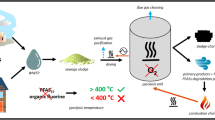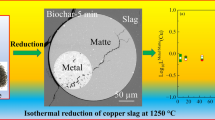Abstract
In this paper, combined with iron-carbon micro-electrolysis-Fenton method, the sludge was adjusted, and the cracking performance and dewatering performance of the sludge were studied. Single factor experiments show that when the amount of iron powder is 1.2 g/L, the reaction time is 45 min, H2 O 2When the dosage was 4.2 g/L, the protein and polysaccharide content in the sludge decreased by 46.8 and 20.6, respectively. Compared with the original sludge %. Compared with the original sludge, the COD of the supernatant of the solution increased by 10.1%. The minimum moisture content of the treated sludge cake was 69%, and the SRF value was significantly reduced.The lowest value is 2.687×10 12 m/kg. During the micro-electric dust removal sludge, the Fe 2+can form a Fenton reagent with H2 O 2, thereby reducing the amount of additional iron powder that needs to be added in the conventional Fenton reaction. Three-dimensional fluorescence spectroscopy analysis showed that the humic acid and fulvic acid in the supernatant of the iron-carbon micro-electrolysis-Fenton conditioning solution increased more than after single electrolysis, indicating that the dehydration performance of the sludge was better.The Fenton reagent is formed , thereby reducing the amount of iron powder that needs to be added extra in the conventional Fenton reaction.





Similar content being viewed by others
Availability of data and information
The data set used and/or analyzed in the current study can be obtained from the corresponding author upon reasonable request.
Reference
Chen P, Chen X, Wang H, et al. (2007) Determination of polysaccharides from Panax japonicus from Hubei Province by sulfuric acid anthrone method [J]. Chin J Hosp Pharm 27 (12)
Chen H, Yi X, Yanxiao S et al (2014) Effect of Fenton reagent oxidation on sludge dewatering performance [J]. Environ Sci Res 27(06):615–622
Faye MCAS, Zhang KK, Peng S, Zhang Y (2019) Sludge dewaterability by dual conditioning using Fenton’s reagent with Moringa oleifera[J]. J Environ Chem Eng 7(1):102838
Feng L, Luo J, Chen Y (2015) Dilemma of sewage sludge treatment and disposal in China[J]. Environ Sci Technol 49(8):4781–4782
Gao Y, Yu Y (2004) Determination of peptide content in cerebroprotein hydrolysate solution by Folin phenol method [J]. Taiwan Pharm J 06:57–58
Garcia-Segura S, Bellotindos LM, Huang YH, Brillas E, Lu MC (2016) Fluidized-bed Fenton process as alternative wastewater treatment technology—a review[J]. J Taiwan Inst Chem Eng 67:211–225
Gjjt 221-2005 (2005) sludge test method for municipal wastewater treatment plants [S]. Ministry of construction of the People’s Republic of China, Beijing
Guan R, Yuan X, Wu Z, Jiang L, Li Y, Zeng G (2018) Principle and application of hydrogen peroxide based advanced oxidation processes in activated sludge treatment: a review[J]. Chem Eng J 339:519–530
Han YH, Li H, Liu ML et al (2016) Purification treatment of dyes wastewater with a novel micro-electrolysis reactor[J]. Sep Purif Technol 170:241–247
Han Y, Qi M, Zhang L, Sang Y, Liu M, Zhao T, Niu J, Zhang S (2019) Degradation of nitrobenzene by synchronistic oxidation and reduction in an internal circulation microelectrolysis reactor[J]. J Hazard Mater 365:448–456
He M, Wei C (2010) Performance of membrane bioreactor (MBR) system with sludge Fenton oxidation process for minimization of excess sludge production. J Hazard Mater 176:597–601
Hjjt 399-2007 (2007) determination of chemical oxygen demand in water quality by rapid digestion spectrophotometry [S]. China Environmental Science Press, Beijing
Hu Z, Li D, Deng S et al (2019) Combination with catalyzed Fe(0)-carbon microelectrolysis and activated carbon adsorption for advanced reclaimed water treatment: simultaneous nitrate and biorefractory organics removal[J]. Environ Sci Pollut Res 26:5693–5703
Lan S, Ju F, Wu X (2012) Treatment of wastewater containing EDTA-Cu(II) using the combined process of interior microelectrolysis and Fenton oxidation–coagulation[J]. Sep Purif Technol 89(none):117–124
Liu Y, Fang HHP (2003) Influences of extracellular polymeric substances (EPS) on flocculation, settling, and dewatering of activated sludge[J]. Crit Rev Environ Sci Technol 33(3):237–273
Lu M, Lin C, Liao C, Huang R, Ting W (2003) Dewatering of activated sludge by Fenton’s reagent. Adv Environ Res 7:667–670
Ning X, Chen H, Wu J, Wang Y, Liu J, Lin M (2014) Effects of ultrasound assisted Fenton treatment on textile dyeing sludge structure and dewaterability[J]. Chem Eng J 242:102–108
Shaolan D, Qianqian T, Dong L (2018) Effect of calcium peroxide pre oxidation on sludge dewatering characteristics [J]. J Shaanxi Univ Sci Technol 36(04):17–22
Shen YH, Zhuang LL, Zhang J et al (2018) A study of ferric-carbon micro-electrolysis process to enhance nitrogen and phosphorus removal efficiency in subsurface flow constructed wetlands[J]. Chem Eng J
Statistical bulletin of urban and rural construction (2017). Ministry of housing and urban rural development of the People’s Republic of China
Van der Zee FP (2003) Activated carbon as an electron acceptor and redox mediator during the anaerobic biotransformation of azo dyes[J]. Environ Sci Technol 37(2):402–408
Wang L, Yang Q, Wang D, Li X, Zeng G, Li Z, Deng Y, Liu J, Yi K (2016) Advanced landfill leachate treatment using iron-carbon microelectrolysis- Fenton process: process optimization and column experiments[J]. J Hazard Mater 318:460–467
Wang L, Ping L, Turhong M, Tao F, Jing W, Jinhua W (2018) Fe ~ 00h_2O_Two kinds of Fenton process to improve sludge dewatering performance and mechanism analysis [J]. Modern Chem Ind 38(12):119–123
Ying D, Peng J, Xu X et al (2012) Treatment of mature landfill leachate by internal micro-electrolysis integrated with coagulation: a comparative study on a novel sequencing batch reactor based on zero valent iron[J]. J Hazard Mater 229-230(none):426–433
Zhang Z. Drainage engineering volume II (4th Edition) [M]. China Construction Industry Press, 2000
Zhang H, Xiang LJ, Zhang DB, Qing H (2012a) Treatment of landfill leachate by internal microelectrolysis and sequent Fenton process. Desalin Water Treat 47:243–248
Zhang X, Lei H, Chen K, Liu Z, Wu H, Liang H (2012c) Effect of potassium ferrate (K2FeO4) on sludge dewaterability under different pH conditions[J]. Chem Eng J 210:467–474
Zhang S, Liang J, Jinjia H et al (2019) Study on improvement of sludge dewatering performance by anoxic acidification combined with zero valent iron hydrogen peroxide [J]. J Environ Sci 39(03):780–789
Zhou J, Lixiang Z, Huanzhong H (2013) Extraction method of sludge extracellular polymer and its effect on sludge dewatering performance [J]. Environ Sci 34(07):2752–2757
Zhu Q, Guo S, Guo C, Dai D, Jiao X, Ma T, Chen J (2014) Stability of Fe–C micro-electrolysis and biological process in treating ultra-high concentration organic wastewater[J]. Chem Eng J 255(7):535–540
Funding
All funds come from Shaanxi University of Science and Technology. The funds are used to purchase laboratory equipment and chemicals.
Author information
Authors and Affiliations
Contributions
All authors contributed to the concept and design of the research. Data preparation, data collection and analysis were carried out by Ding Shaolan, Zhao Zhen, Tian Qianqian, Li Danqing and Ren Huijun. The first draft of the manuscript was written by Zhen Zhao, and all authors commented on previous versions of the manuscript. The final manuscript read and approved by all authors.
Ding Shaolan: Ideas; formulate or develop overall research goals and objectives
Zhao Zhen, Tian Qianqian, Li Danqing: Provide research materials, reagents, materials, patients, laboratory samples, instruments, computing resources or other analytical tools; methodological development or design; model creation
Zhao Zhen, Ren Huijun: Preparation, creation and/or introduction of published works, especially writing the first draft (including substantive translation)
Corresponding author
Ethics declarations
Moral recognition
"Not applicable"
Agree to participate
"Not applicable"
Agree to publish
Participants have agreed to submit the case report to the journal.
Fight for interests
The author declares that there is no conflict of interest.
Additional information
Responsible Editor: VítorJP Vilar
Publisher’s note
Springer Nature remains neutral with regard to jurisdictional claims in published maps and institutional affiliations.
Rights and permissions
About this article
Cite this article
Ding, S., Zhao, Z., Tian, Q. et al. Effect of Iron-Carbon Micro-Electrolysis-Fenton on the Dewatering Performance of Sludge. Environ Sci Pollut Res 28, 47126–47135 (2021). https://doi.org/10.1007/s11356-021-13514-4
Received:
Accepted:
Published:
Issue Date:
DOI: https://doi.org/10.1007/s11356-021-13514-4




